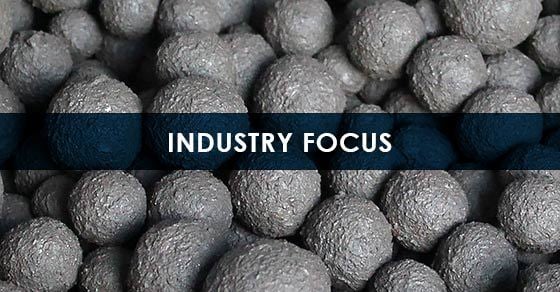As sulfide nickel ore deposits decline in both number and grade, many industry experts see upgrading low-grade laterite ores as an essential step in satiating rising nickel demand in the transition to a low-carbon economy.
A combination of reduction roasting and magnetic separation has emerged as a promising solution. To improve the effectiveness of this approach, however, many producers are opting to pelletize nickel ore prior to roasting.
The following information covers the basics behind this process and how pelletizing contributes to its success.
A New Way to Process Nickel Laterite Ores
Low-grade nickel laterite ores hold strong potential as a source of feedstock for ferronickel and nickel matte production, but only if the nickel content can be economically upgraded.
Processing low-grade nickel laterites with existing technology is problematic for several reasons, most notably the ore grade requirements of current production techniques.
By selectively roasting low-grade laterites with either sulfur, sulfate, or chloride (along with a few other additives) at a relatively low temperature, and then running the feed through wet magnetic separation, an upgraded ferronickel concentrate suitable for further use can be produced.
Many factors influence the success of this process, including the chosen additive, roasting temperature, and retention time, with research into process optimization ongoing. Many operations are choosing to implement a pelletizing step to improve the efficiency of the roasting/reduction process.
About Pelletizing
Pelletizing is a form of tumble-growth or agitation agglomeration, also known as wet granulation. In metallurgy, it is often referred to as “balling” since the process yields balls of material.
Through the use of agitation and a liquid binder, this process causes particle fines to join together and continue to grow through a layering effect similar to rolling a snowball.
The round pellet product this process yields has proven to offer significant benefits in pyrometallurgical applications and has seen growing implementation as a result.
In the case of nickel laterites, the ore is typically crushed and ground, then mixed with the chosen reductant and any other additives, and pelletized into pellets in the range of 10-15mm.
As with other metallurgical applications, pelletizing may be carried out using either a rotary drum (balling drum) or disc pelletizer (balling disc).
Why Pelletize Nickel Laterites for Reduction?
The primary aim of pelletizing the nickel laterite feed prior to reduction lies in maximizing the efficiency of the roasting step by improving bed permeability.
Improving the bed permeability, or how well gases are able to move throughout the material bed, maximizes the surface area in contact with the gases to assist in ensuring maximum recovery. For the same reasons, steel producers pelletize iron ore prior to smelting.
Pelletizing also mitigates the loss of material otherwise common when working with powders and fines as they transition through process steps and transfer points.
Pelletizing Laterite Fines
Interestingly, pelletizing is assisting in the recovery of nickel from laterite ores in another way as well: nickel dust recovery.
Laterites tend to exhibit a high fines content. As a result, a significant amount of fines are produced during initial handling and processing. Further, fines are also produced during each subsequent step throughout the most commonly employed route of processing higher-grade laterites – the Rotary Kiln Electric Furnace, or RKEF method.
The result is a lot of nickel-bearing dust and fines, which would otherwise be challenging to recover. By pelletizing these fines, however, producers are able to maximize nickel recovery while also keeping materials out of tailings heaps, among other benefits.
Testing Nickel Ore & Dust Pelletizing
As nickel pelletizing is comparatively new, feasibility and process development testing such as that carried out in the FEECO Innovation Center will likely play an important role in helping producers to commercialize their pelletizing process.
Through testing in the FEECO Innovation Center, producers can confirm proof of concept, proof of product, and proof of process using their specific source of nickel. This helps to identify potential issues early, work out key process variables, and establish process parameters necessary for scale-up. This data can then be used in the design of commercial-scale equipment.
The Innovation Center offers both batch- and pilot-scale testing for pelletizing, with disc pelletizers and a rotary drum available.
Conclusion
Low-grade nickel laterite ores will be an important source of the metal in the future as demand increases in the face of declining ore grades. As nickel producers continue to implement the reduction roasting-magnetic separation process as an avenue to economic upgrading, pelletizing will likely play an essential role, helping to maximize the efficiency of upgrading.
FEECO is a leading provider of pelletizing equipment, including disc pelletizers and balling drums. We also offer extensive testing capabilities, as well as parts and service support. For more information on our pelletizing equipment and services, contact us today!

